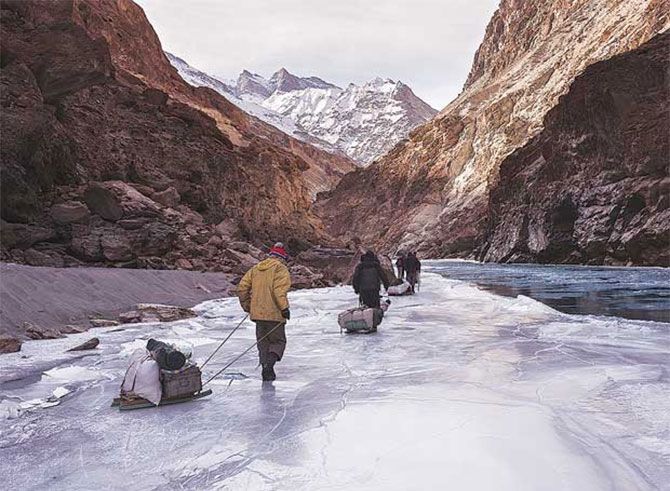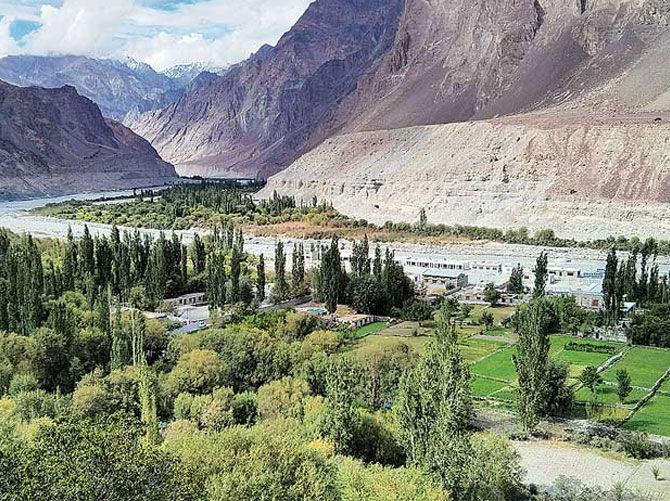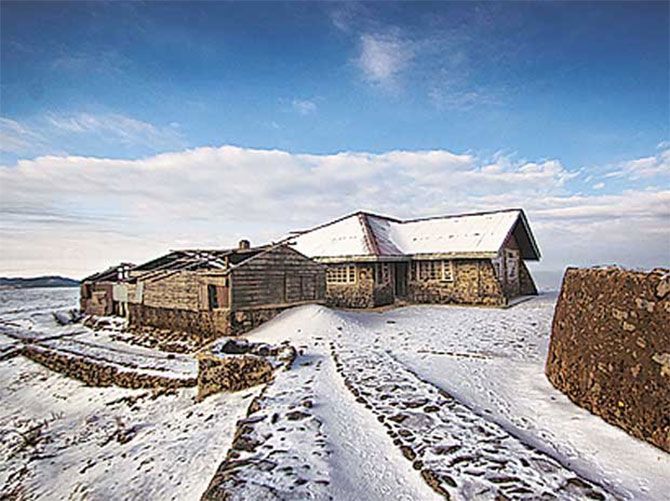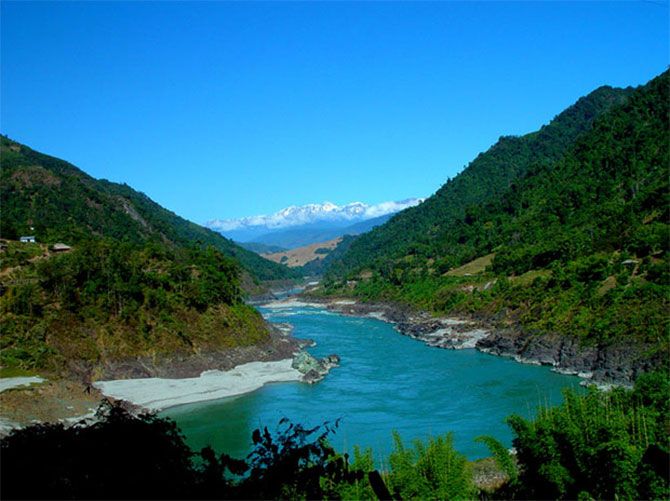 | « Back to article | Print this article |
Here are 5 ways to soak in the wild beauty of the snowy outdoors. Take your pick!
1. Walking on ice

Where: Chadar trek, Ladakh, Jammu & Kashmir
Grade: Challenging
Best time: Late January-early February
The fact that this trek starts from a village called Chilling is an indication of things to come. With freezing temperatures of minus 30 degrees and a precarious walk on the frozen Zanskar river, the Chadar trek promises an experience like no other.
Zanskar, a remote valley in Ladakh and the fabled land of the white copper, is famous for its snow leopards, ibex, black wolves and the rare Himalayan blue poppy. But this mysterious land has no entrance. Two rivers, which flow through it, come together to carve a gorge so deep that one can't travel down it to enter or exit the region.
In summer, the melted snow fires the rivers to a raging frenzy, making the gorge and water routes impassable. The one route is through the Zanskar range of mountains, the high passes of which are closed for eight months. In such a scenario, the only way out is in the winter when a frozen white corridor, or chadar, is formed on the river, creating the only link between the locals and the world outside .
Trekkers usually plan this tour for months, getting the timing right to the dot. There are scores of travel companies offering guides for the tours, but you need to be careful while selecting one for this extreme trek. "You can tell a good guide from the rest from the number of days he offers for acclimatisation," says Karn Kowshik who runs Geck & Co Adventurers.
The hundreds of trekkers thronging to the frozen river have ended up making the ecosystem fragile, with garbage being thrown freely. The Ladakh Council has now limited the number of trekkers in each group to 10.
"There were guides from some travel companies who were taking up to 25 people in a group. Greater control is being exercised now," says Fay Singh, head (operations) of adventure travel company Aquaterra Adventures. Aquaterra runs an 11-day tour from Delhi to Leh, including the Chadar trek, which offers a glimpse of the monasteries dotting the landscape, overnight camping at Teeb cave, lunch atop a steep canyon, a day with the colourful folk of the Nyrek village, and, of course, the famous Chadar walk.
2. Where myths come alive

Where: Brahmatal, Uttarakhand
Grade: Moderate
Best time: January and February
It's not the destination but the journey that matters. Nothing could describe the Brahmatal trek better. Myths and legends leap out from every turn you take through the snow-laden oak forests of Uttarakhand. The base for this six-day trek is Lohajung at an altitude of 7,700 feet. This, locals believe, was the site of a fight between the goddess Parvati and the demon Lohasur.
Weaving through rhododendron trees and the houses of Mandoli village, you will spot the Kail valley formed by the Kail and Pindari rivers. You can stop for a brief lunch in the Navali bugyal (high altitude meadow) and gaze at the formidable Himalayan ranges. After passing through frozen lakes, on Day Four you finally embark on a curved trail to reach the Brahmatal top at a height of 10,738 feet. En route, you might spot the trishul on a clear day, making the climb worth it.
"With high snow, not many treks can be done in January and February. But Brahmatal is an exception," says Arjun Majumdar, founder of Indiahikes. "Even with good dollops of snow, the trail winds through, climbing steadily to Brahmatal, a large tarn in a crater-like depression on top of a mountain," This is a fairly new but no less exciting winter trek.
3. In custom-rich Turtuk

Where: Turtuk, Ladakh, Jammu & Kashmir
Grade: Easy
Best time: March 19 to 26
Celebrate the last dregs of winter in the small village of Turtuk, which is the last Indian outpost located at an altitude of 3,048 metres in Ladakh's picturesque Nubra valley.
Situated on the banks of the Shyok river, Turtuk opened to tourists only in 2009 and offers easy treks to gompas and waterfalls located a couple of hours away. The locals here are very attached to their customs and are versed in Baltistani, Urdu and Ladakhi languages.
Plan ahead and visit the village in March when the locals celebrate the Navroz festival. In fact, adventure companies like Banjara Camps and Retreats plan special eight-day tours around that time, which include a visit to the famous Shey and Thiksey monasteries, Stok Palace and Shanti Stupa.
Besides dance performances and live music, the highlight of the week-long festivities is the Polo match, played on one of the highest grounds in the world.
4. On top of the world

Where: Sandakphu, West Bengal
Grade: Moderate
Best time: First week of October to April
This is the only trek in India that offers a view of four of the world's tallest mountains: Everest, Kanchenjunga, Makalu and Lhotse.
The highest point in West Bengal at an altitude of 11,929 feet, Sandakphu lies in the district of Darjeeling. The path to it follows the iconic Singalila Ridge, which forms the border between Sikkim and Nepal.
"Sandakphu is best done in winter, though most people trek to it in other seasons. And that's too bad," says Majumdar of Indiahikes. "In winter, when the air is crisp and there is no haze in the sky, the sight of the four mountains can bring tears to your eyes. When you punch in views of Nuptse and even Pandim, trekkers are spoilt for choice."
The view stays with you through the seven days that you walk the ridge between Sandakphu and Phalut.
The trek from Maneybhunjung takes you to the check post of Singalila National Park, where you obtain a permit to get in. The park is home to the elusive Red Panda and hundreds of birds.
From there the road bifurcates and takes you to the Nepalese villages of Joubari and Ila, getting you back to the Indian settlement of Gairibas for tea and noodles. "The trek dips in and out of Nepal multiple times - sometimes you don't know which country you are in. You don't need a passport though," says Majumdar.
5. A day with the Mishmis

Where: Wakro Valley, Arunachal Pradesh
Grade: Easy to moderate
Best time: End of March
Marked by unique hairdos, cane head dresses, tattooed faces and nose plugs, the Mishmi tribe has long been an enigma for anthropologists and travellers alike.
To get a whiff of their vibrant culture, head to Wakro valley in Arunachal Pradesh after landing in Dibrugarh, Assam.
Considered the original inhabitants of the Lohit district, Mishmis are divided into three sub-tribes: Idu, Digaru and Miju, each with its own dialect and distinctive dress. Walk around Wakro to visit local villages such as Kanjan and Pukhuri.
As part of the seven-day tour organised by Banjara Camps and Retreats, one can travel to Roing from Wakro, a region characterised by snowcapped mountains, archaeological sites and rich flora. En route,you can do a short walk to the holy site of Parasuram Kund. Once at Roing, you can trek up or drive to the Mayodia Pass to experience the magic of fresh snowfall or get lost in the lush green forests in the area.
Go prepared
Without the right training and gear to navigate the terrain, amateurs should not embark on a winter trek.
"All treks, even easy ones, become challenging in winter because of the snow," says Kowshik of Geck & Co Adventurers, who runs two courses on how to navigate the great outdoors.
When on a snow trek, make sure you are equipped with down jackets and snow racquets, which are fitted onto shoes so that you don't sink into the snow.
You can also rent these from the Indian Mountaineering Foundation in Delhi.
Photographs: Business Standard